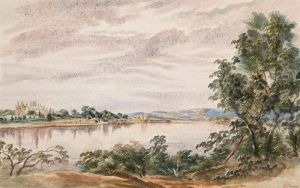Samuel Elyard Paintings
Samuel Elyard was an English-born artist who became known for his work in Australia, particularly for his watercolor paintings that depict early colonial life and landscapes. Born on June 1, 1817, in Portsmouth, England, Elyard's artistic journey began in his homeland, but his most influential period would come after his migration to Australia in the 1830s. His move was part of the broader wave of British colonization and settlement in Australia during that era. Elyard's work provides valuable insights into the colonial period, capturing the transformation of the Australian landscape and the burgeoning settlements that would grow into today's cities.
Elyard was not just a painter; he was also recognized for his skills as a draughtsman and lithographer. His ability to capture the essence of the Australian landscape, with its unique flora and sprawling vistas, made his work popular among settlers and historians alike. He often focused on the picturesque and pastoral, presenting an idealized vision of colonial life that was serene and bountiful. This perspective was reflective of the times, as art played a role in promoting colonial Australia as a land of opportunity and beauty.
Despite the romanticized view presented in his paintings, Elyard's work is valuable for its historical accuracy in detailing the architecture, fashion, and daily life of early Australian settlers. His paintings serve as a window into the past, offering a visual record of the changes that took place during his lifetime. Throughout his career, Elyard exhibited his work in various venues, including the Australian Academy of Art, contributing significantly to the country's cultural heritage.
Samuel Elyard lived through a century of profound change, passing away on July 10, 1910. His legacy is preserved in numerous collections and galleries across Australia, including the National Library of Australia and the State Library of New South Wales. Through his art, Elyard has left behind a rich visual history of Australia's early colonial period, making him an important figure in both Australian art and history.
